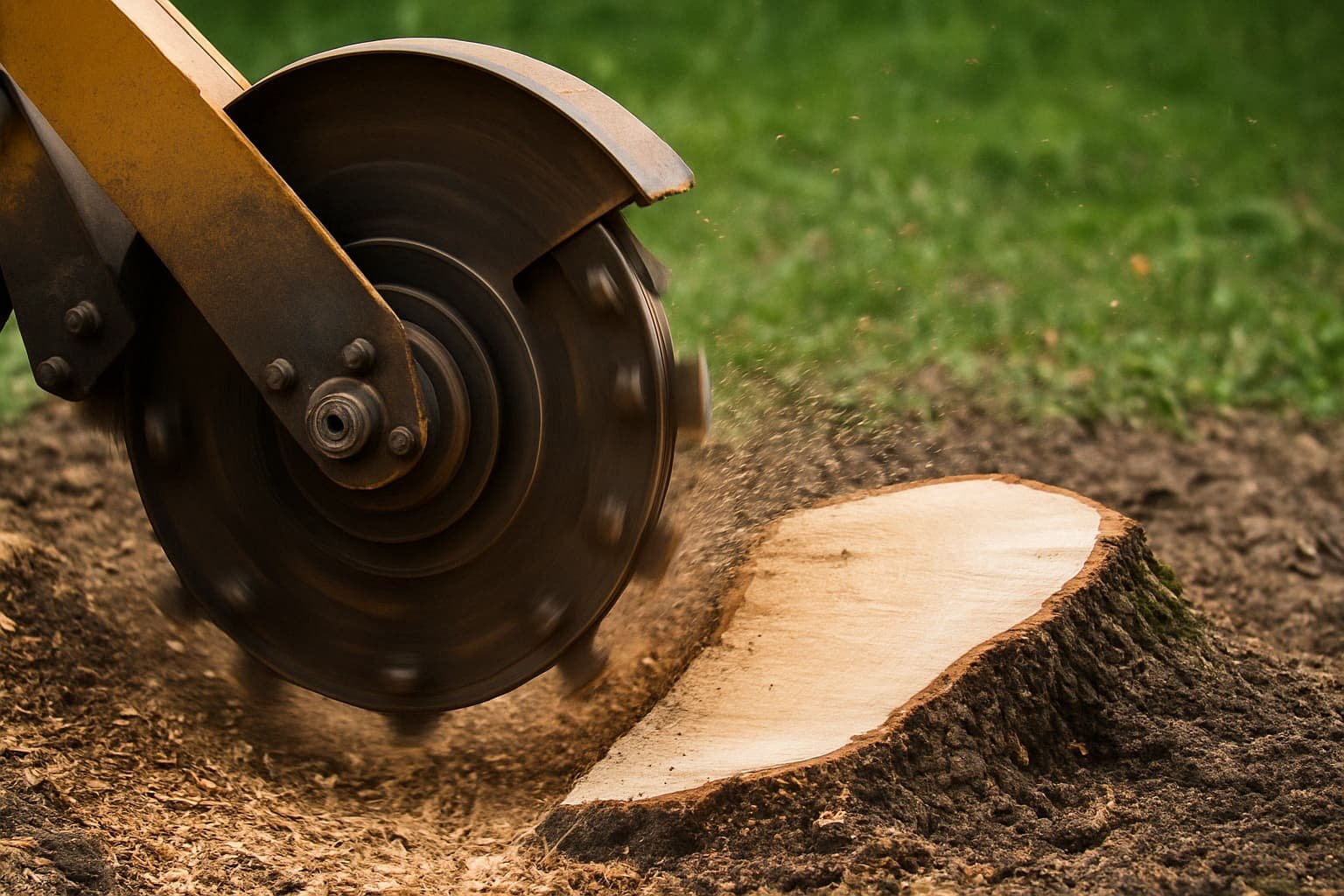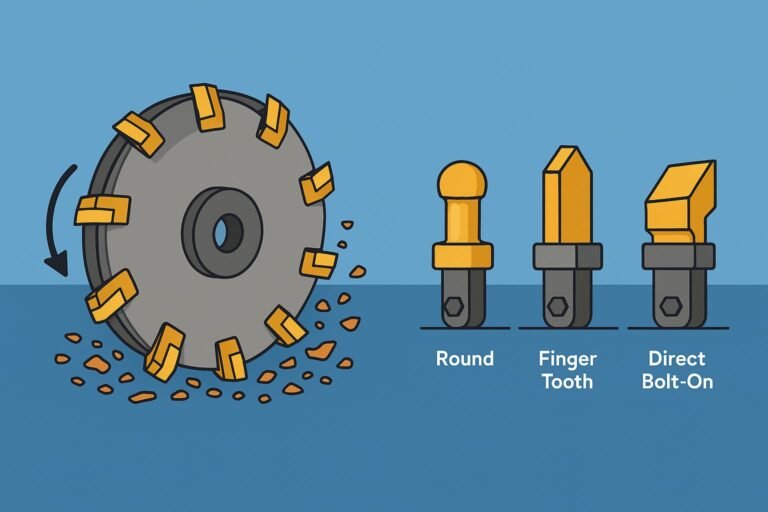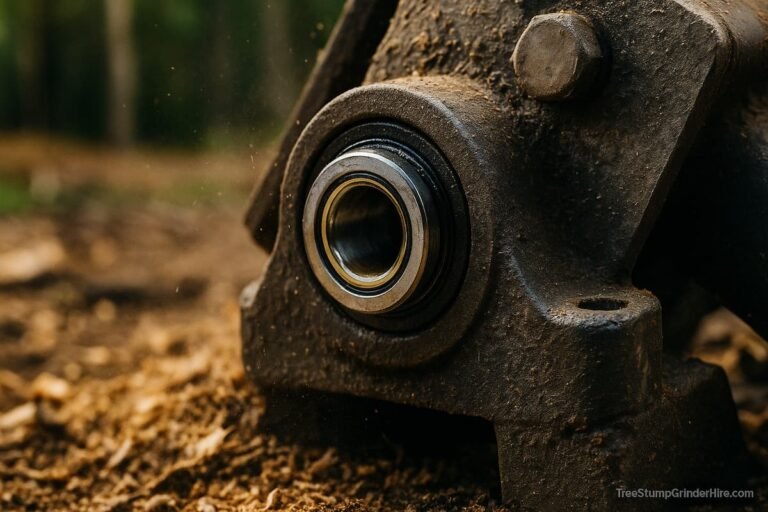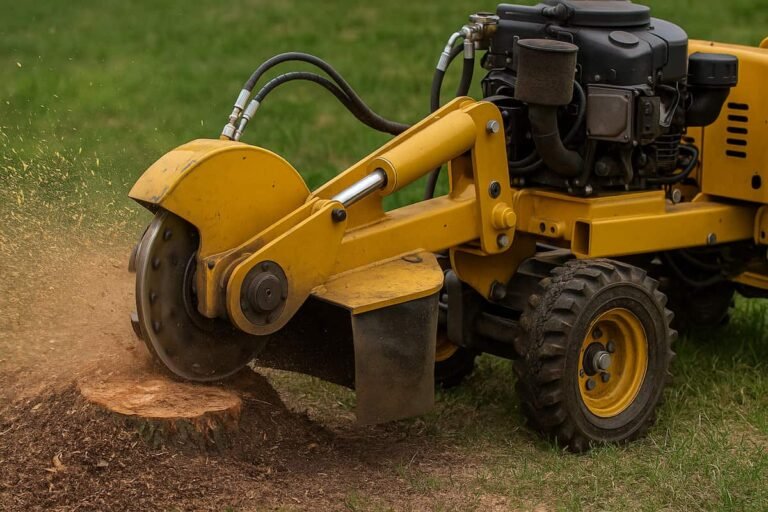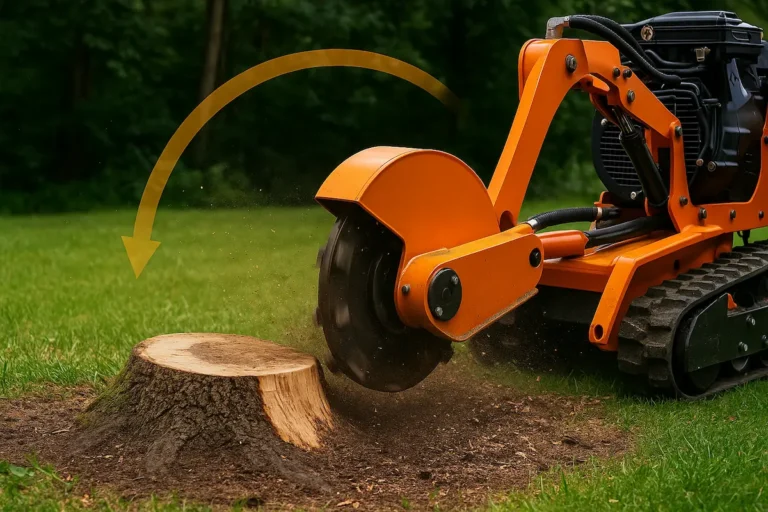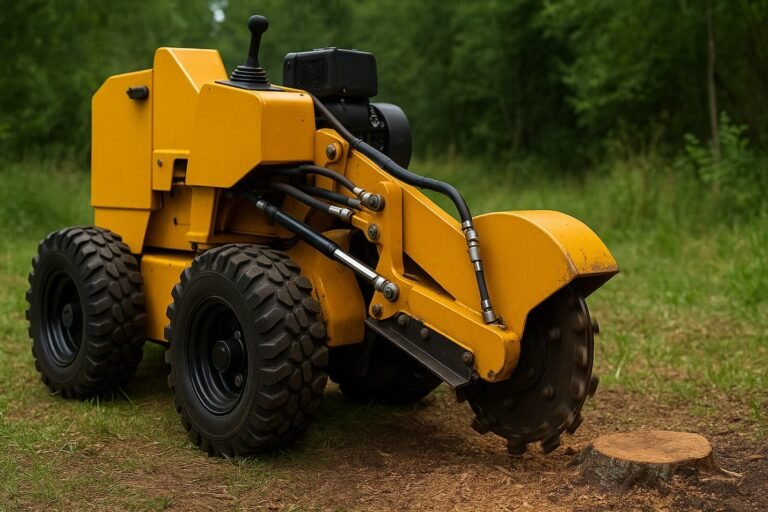Understanding Stump Grinder Cutting Width (The “Kerf” Concept) for Efficient Hire
You might have heard the word “kerf” used with saws.
It means the gap a saw blade makes when it cuts wood.
Does “kerf” matter for stump grinders? Not really by that name.
But the idea behind kerf – the width of the cut – is super important.
Knowing about cutting width helps you hire the right stump grinder.
It enables you to get your stump removed faster.
Understanding Stump Grinder Cutting Width (Sweep Arc)
Key Takeaways from the Chart
- Sweep Arc is Key: The chart compares the typical maximum “”Sweep Arc”” (effective cutting width range) of different stump grinder sizes. This is crucial for job speed.
- Small Grinders (Compact): Offer a narrower sweep arc (~40 inches max), making them suitable for smaller stumps or where access is restricted (e.g., narrow gates ~30 inches). They are generally slower on larger stumps.
- Large Grinders (Tow/Tracked): Provide a significantly wider sweep arc (~70 inches max), allowing for much faster grinding of large stumps. However, they require wider access (>36 inches).
- Choosing Wisely: Balance the need for a wide sweep (for speed on large stumps) against the physical access limitations of your site. Measure access paths carefully before hiring.
What is “Kerf”, and Does it Directly Apply to Stump Grinding?
Let’s clear things up straight away.
People don’t usually say “kerf” when talking about stump grinding.
It’s not the regular word operators use every day.
Define Kerf in Traditional Cutting (e.g., Saws)
Think about cutting wood with a hand saw or a power saw.
The saw blade has a specific thickness.
When the blade cuts through the wood, it removes a thin strip.
That thin strip, turned into sawdust, is the kerf.
It’s simply the width of the cut the saw blade makes.
A saw might make a 3mm wide kerf, for example.
Explain Why “Kerf” Isn’t Standard Stump Grinding Terminology
Stump grinders work differently from saws.
They don’t have one long blade making a straight cut.
Instead, they use a spinning wheel with lots of sharp teeth.
This wheel moves side to side across the stump.
It chips away the wood bit by bit.
So, there isn’t one single “kerf” line like with a saw.
Operators talk about the grinder’s action using different words.
They focus on how wide a path the grinder clears in one go.
Discover the Right Terms: Cutting Width and Sweep Width Explained
So, if not “kerf,” what words should you use?
Two terms are much more common and valuable.
These are “cutting width” and “sweep width.”
They both describe how much stump the grinder tackles sideways.
Introduce “Cutting Width” as the Key Concept
Cutting width is the main idea to understand.
This means that the grinder clears the grinder’s width of the stump surface with its wheel.
Imagine the grinder wheel is like a very wide paintbrush.
The cutting width is how wide a stripe it paints (or grinds) on the stump.
A grinder with a bigger cutting width can clear more stumps faster.
This is similar to the idea of kerf but fits how grinders work better.
Define “Sweep Width” / “Sweep Arc” in Grinder Operation
Sweep width (or sweep arc) means how far the grinder head can move from side to side.
The grinder head holds the spinning cutting wheel.
The operator sweeps this head left and right across the stump.
The sweep width is the total distance it can travel from one side to the other.
A wider sweep width lets the operator grind a wider area without moving the whole machine.
This is directly related to the cutting wheel’s size and the machine’s design.
“Forget ‘kerf’. Ask about the cutting width or sweep arc when you hire. That tells you how fast it can work on big stumps.” – Experienced Operator (Paraphrased insight from forums)
Think of it like this:
- Cutting Width: The width the wheel grinds at any moment.
- Sweep Width: The total side-to-side distance the wheel can cover easily.
Both are vital for grinding speed.
See How Stump Grinders Achieve Their Cutting Width
How does a stump grinder chew through wood?
It’s all about the spinning wheel and how the operator moves it.
Describe the Grinder’s Sweeping Action
A stump grinder doesn’t just plunge straight down.
The main action is sweeping the cutting wheel from side to side.
The operator moves the wheel slowly and smoothly across the face of the stump.
Each pass removes a layer of wood.
Then, the operator lowers the wheel slightly for the next sweep.
This process repeats, going lower and lower.
The width of each sweep is key to how quickly the stump disappears.
Explain the Role of the Rotating Cutting Wheel and Teeth
The cutting wheel is the business end of the grinder.
It’s a heavy metal disc, often quite large on bigger machines.
Studded around the edge of the wheel are cutting teeth.
These teeth are usually made from very hard material, like carbide.
They act like tiny chisels, chipping away the wood as the wheel spins fast.
The number of teeth and the wheel’s width determine the potential cutting width.
Sharp, well-maintained teeth cut cleanly and efficiently.
Dull or damaged teeth make the grinder slow and struggle.
They won’t achieve the full potential cutting width easily.
Maximise Your Grinding Speed: Why Cutting Width Matters
Why should you care so much about cutting width?
It directly impacts how fast the stump removal job gets done.
A wider cut means less work and less time.
Link Wider Cuts Directly to Faster Stump Removal
Imagine colouring in a large circle.
Using a crayon with a fine point takes ages. You need many strokes.
Using a thick marker pen covers the area much quicker. You need fewer strokes.
Stump grinding is similar.
A grinder with a narrow cutting width is like a fine crayon.
It needs many back-and-forth sweeps to cover the whole stump.
A grinder with a wide cutting width is like a thick marker.
It covers more ground with each sweep.
Fewer sweeps mean the stump is ground down much faster.
On large stumps, this difference can save hours of work.
Understand the Impact on Overall Job Time and Effort
Faster grinding isn’t just about saving time.
This also means the grinder uses less fuel.
This means less time is spent operating the machine, which can be tiring.
If you hire a grinder by the hour or day, faster work saves you money.
If you do the job yourself, faster work means less physical effort.
So, a wider cutting width leads to:
- Quicker job completion
- Lower fuel costs (potentially)
- Less operator fatigue
- Better value-for-hire costs
“Went from a small grinder to a bigger one. The wider sweep cut my grinding time in half on those monster stumps.” This is a common sentiment in YouTube comments.
Identify Key Factors That Determine a Grinder’s Cutting Width
What decides how wide a cut a grinder can make?
Several essential things work together.
It’s not just one single factor.
Compare Machine Size and Type (Portable vs. Tracked/Tow-Behind)
Stump grinders come in different sizes.
- Small Portable Grinders: These are often pushed by hand or are small self-propelled units. They fit through narrow garden gates (often under 30 inches wide). They have smaller engines and smaller cutting wheels. Their cutting width and sweep arc are narrower. Suitable for tight spots but slower on big stumps. Example: Toro STX-26 might have a sweep arc of around 34 inches.
- Large Tow-Behind or Tracked Grinders: These are much bigger and heavier. They need to be towed by a vehicle or moved on tracks. They have powerful engines and large cutting wheels. They offer a much wider cutting width and sweep arc. They are great for big stumps in open areas. For example, Vermeer SC802 might have a sweep arc of around 70 inches.
Hire Choice: You must match the machine size to your stump size and how easy it is to get it to the stump (Access).
Assess Cutting Wheel Diameter and Physical Width
The size of the cutting wheel itself is a significant factor.
Larger diameter wheels (e.g., 25-30 inches) generally allow for a wider effective cut than smaller wheels (e.g., 10-15 inches).
The physical width of the wheel edge also plays a part.
Wider wheels with more teeth across their width can clear a wider path.
Manufacturers specify these dimensions for their models.
Evaluate Tooth Type and Condition for Effective Cutting
The teeth do the actual cutting work.
Their type and condition are essential.
- Tooth Type: Different teeth designs exist. Some are better for sandy soil, others for clean wood. Using the right type helps the grinder cut efficiently across its full width.
- Tooth Condition: Sharp teeth are essential! Dull, chipped, or missing teeth drastically reduce cutting speed. The grinder will struggle, vibrate more, and take smaller bites. It won’t achieve its potential cutting width. Regularly checking and sharpening/replacing teeth is vital for performance.
“Don’t underestimate sharp teeth. They make a world of difference to how wide and deep you can cut smoothly.” This advice is often shared on Arborist forums.
Recognise How Operator Technique Influences the Effective Cut
How the person uses the grinder also matters a lot.
A skilled operator gets more from the machine.
- Sweep Speed: Moving the wheel side-to-side too fast strains the engine. It might not clear the wood properly. A smooth, steady sweep is best.
- Depth of Cut: Grinding too deep with each pass can stall the machine. This is especially true for smaller grinders or hardwood. Taking shallower bites allows for a consistent, broad sweep.
- Overlap: Overlapping each sweep slightly ensures no ridges are left. However, too much overlap reduces the new ground area on each pass. Good technique balances coverage and speed.
Even a machine with a wide potential cut won’t work well if poorly used.
Consider How Stump Characteristics (Wood Type, Size) Affect Width
The stump itself influences the grinding process.
- Wood Type: Hardwoods like oak or cherry are tougher to grind than softwoods like pine or fir. Operators usually take shallower bites and maybe slower sweeps on hardwoods. This affects the practical cutting width achieved per minute.
- Stump Size: Larger diameter stumps take longer. A wide cutting width becomes much more critical here.
- Roots and Soil: Grinding below ground level involves dealing with roots and soil. Rocks or debris in the soil can damage teeth and slow progress. Dense root systems also require careful grinding.
Choose the Best Stump Grinder Hire for Your Needs
Hiring a stump grinder saves you from buying an expensive machine.
But you need to pick the right one for your specific job.
Thinking about cutting width and Access is key.
Balance Cutting Width Needs with Site Access Limitations
This is often the most significant decision.
Do you need maximum cutting width for big stumps? Or do you need a narrow machine to get through a gate?
- Wide Access (e.g., front garden, open field): You can likely hire a larger, more powerful grinder. This machine will have a wider cutting width and finish the job faster, especially on large stumps.
- Narrow Access (e.g., back garden gate, tight path): You will be limited to smaller, compact grinders. These have narrower cutting widths. The job will take longer, but at least you can get the machine to the stump. Measure your access path carefully before hiring!
Key Question: What narrow point does the grinder need to pass through?
Match Machine Specifications (Sweep Arc) to Your Stump Size
Look at the hire company’s machine details.
They should list the sweep arc or cutting width.
- Small Stumps (e.g., under 15 inches in diameter): A smaller grinder with a narrower sweep (e.g., 30-40 inches) might be perfectly fine and easier to handle.
- Medium Stumps (e.g., 15-30 inches diameter): A medium-sized grinder with a decent sweep (e.g., 40-55 inches) will be more efficient.
- Large Stumps (e.g., over 30 inches in diameter): A large grinder with a broad sweep (e.g., 50+ inches) is highly recommended if Access allows. It will save significant time and effort.
Don’t just hire the cheapest or the first one you see. Check the specs!
Analyse Small Grinder Capabilities: Pros and Cons of Narrower Cuts
Smaller stump grinders have their place.
They are often the only choice for specific jobs.
Let’s look at their good and bad points regarding cutting width.
When to Hire Compact Grinders (Tight Access, Smaller Stumps)
Hire a small, compact grinder when:
- Access is limited: You must fit through a standard garden gate (usually around 30-36 inches).
- Stumps are small: Removing small-diameter stumps doesn’t take too long, even with a narrower cut.
- Working on slopes: Some smaller tracked models handle slopes better than larger wheeled ones.
- Budget is tight: Smaller machines often have lower hire rates (but remember they might take longer).
- You prefer easier handling: They are lighter and less intimidating to operate for beginners.
Acknowledge Potential Time Increase with Narrower Sweep Widths
The main drawback of small grinders is speed.
Their narrower cutting width means more sweeps are needed.
Each pass removes less wood compared to a larger machine.
Expect the job to take longer, especially on medium to large stumps.
If you have many stumps, the extra time adds up significantly.
When hiring a small grinder for big tasks, be realistic about the time commitment.
“Had to use the small grinder for that back garden stump. Took ages making tiny passes, but it was the only machine that fit through the gate.” – Common DIY hire experience.
Evaluate Large Grinder Advantages: The Power of a Wide Sweep
If you have the space, larger grinders offer profound benefits.
Their wide-cutting path makes a huge difference.
Identify When to Hire Larger Machines (Large Stumps, Open Access)
Choose a large tow-behind or tracked grinder when:
- Access is wide open: No narrow gates or paths to worry about.
- Stumps are large (diameter or quantity): You need power and efficiency.
- Time is essential: You want the job done as quickly as possible.
- You are clearing multiple stumps: The time saved per stump adds up.
- You need deep grinding: Larger machines often grind deeper below ground level.
Appreciate the Efficiency Gains from Wider Cutting Paths
The broad sweep is the superpower of large grinders.
They chew through large stumps much faster.
Fewer passes are needed across the stump face.
The powerful engine handles broader and deeper cuts more easily.
This dramatically reduces the total grinding time.
Large grinders are essential for commercial operators or those with big clearance jobs.
Simple Comparison Table:
| Feature | Small/Compact Grinder | Large Grinder (Tow/Tracked) |
|---|---|---|
| Access | Fits narrow gates (~30″”) | Needs wide access (>36″”) |
| Cutting Width | Narrower (~30-40″” sweep) | Wider (~50-70+”” sweep) |
| Stump Size | Best for Small / Medium | Best for Medium / Large |
| Speed | Slower | Faster |
| Handling | Easier, lighter | Heavier, more powerful |
| Hire Cost | Often lower per day/hour | Often higher per day/hour |
Common Problems Summary Box
- Problem: We are hiring a too small grinder for the stump/access.
- Result: The job takes much longer than expected and requires more effort.
- Solution: Measure access width before hiring. Match the grinder size (and cutting width) to the stump size if Access allows.
- Problem: Trying to grind too fast or too deep.
- Result: Stalling the machine, excessive vibration, poor finish.
- Solution: Use smooth, steady sweeps. Take shallower bites, especially with smaller machines or hardwood. Let the machine do the work.
- Problem: Using a grinder with dull or damaged teeth.
- Result: Very slow cutting, bouncing, potential machine damage.
- Solution: Check teeth condition before starting. Ask the hiring company if your teeth are sharp. Stop if cutting becomes very slow – teeth may need attention.
- Problem: The below-ground grinding depth is not considered needed.
- Result: Leaving roots near the surface, hindering replanting or paving.
- Solution: Decide how deep you need to grind. Check the machine’s maximum grinding depth spec before hiring.
Learn from Practical Examples: Cutting Width in Action
Seeing how cutting width works in real jobs helps to understand.
Let’s look at two common scenarios.
Case Study Insights: Efficient Large Stump Removal (Wide Cut)
Imagine a company clearing land for building.
They have ten large oak stumps, each over 3 feet wide.
The area is open, with easy Access to big machines.
They hire a large tracked stump grinder.
This machine has a wide cutting wheel (maybe 27 inches in diameter).
It has a vast sweep arc (perhaps 65 inches).
The operator can make broad, powerful sweeps across each stump.
Because the cutting width is so large, fewer passes are needed.
The powerful engine cuts through the hard oak wood efficiently.
Result: Each large stump is ground down relatively quickly. The wide cutting width makes the job much faster than using a small grinder.
(Based on typical commercial operations shown online)
Case Study Insights: Navigating Backyard Access (Narrower Cut)
Imagine a homeowner with a medium-sized pine stump (18 inches wide).
The stump is in their back garden.
The only way in is through a standard garden gate (32 inches wide).
They need to hire a compact, self-propelled grinder.
This machine is designed to fit through narrow gaps.
It has a smaller cutting wheel (maybe 14 inches in diameter).
Its sweep arc is much narrower (around 35 inches).
The operator gets the machine through the gate easily.
They grind the stump by making many more side-to-side sweeps.
The cutting width is narrower, so each pass removes less wood.
Result: The stump gets removed successfully. However, the job takes longer because of the narrower cutting width dictated by the access limits.
(Based on common DIY hire scenarios)
These examples show the trade-off:
- Wide Access allows for wider cuts and faster work on big stumps.
- Narrow Access forces machines with narrower cuts, increasing job time.
Key Takeaways: Applying Cutting Width Knowledge to Your Stump Grinder Hire
Understanding cutting width helps you make more intelligent choices.
It enables you to get the right machine for your stump removal job.
Remember these key points when you hire.
Prioritise Checking Machine Cutting Width/Sweep Specs Before Hiring
Don’t just look at the engine size or daily hire price.
Find the cutting width or sweep arc specification.
Hire companies should provide this information.
Think about how wide your stumps are.
Match the machine’s capability to your job’s needs.
Use “Cutting Width” and “Sweep Width” When Discussing Requirements
When talking to the hiring company, use these terms:
Ask: “What is the sweep width of this grinder?”
Ask: “Is the cutting width suitable for a stump of X size?”
This shows you understand what affects performance.
It helps them recommend the best machine for you.
Avoid using the word “kerf” as it might confuse.
Remember, Wider Cuts Equal Faster Work (Access Permitting)
The basic rule is simple.
If you can get a wider machine to the stump, it will generally work faster.
Wider cutting width = Fewer passes = Less time.
Always measure your access route first.
Balance the need for speed (wide cut) with the reality of Access (machine size).
Choosing the right grinder based on cutting width and Access saves time, effort, and potentially money.
Ready to find the right machine for your job?
Check out our tree stump grinder hire listings to compare machines and find one near you!

